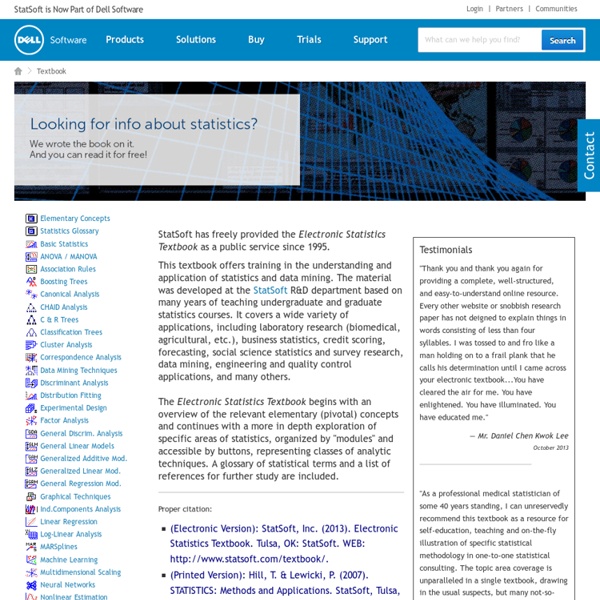Zoom
Trash



http://www.statsoft.com/Textbook
Related: HSH216 Epidemiology & Biostatistics 2Menu OpenEpi provides statistics for counts and measurements in descriptive and analytic studies, stratified analysis with exact confidence limits, matched pair and person-time analysis, sample size and power calculations, random numbers, sensitivity, specificity and other evaluation statistics, R x C tables, chi-square for dose-response, and links to other useful sites. OpenEpi is free and open source software for epidemiologic statistics. It can be run from a web server or downloaded and run without a web connection. A server is not required. Black-Scholes Model In their 1973 paper, The Pricing of Options and Corporate Liabilities, Fischer Black and Myron Scholes published an option valuation formula that today is known as the Black-Scholes model. It has become the standard method of pricing options. The Black-Scholes formula calculates the price of a call option to be: C = S N(d1) - X e-rT N(d2) where Put-call parity requires that:
Probability and statistics EBook - Socr From Socr SOCR Books: This is a General Statistics Curriculum E-Book, which includes Advanced-Placement (AP) materials. Preface This is an Internet-based probability and statistics E-Book. The materials, tools and demonstrations presented in this E-Book would be very useful for advanced-placement (AP) statistics educational curriculum. The E-Book is initially developed by the UCLA Statistics Online Computational Resource (SOCR). The Central Limit Theorem To understand the wildness of samples, we would choose thousands of samples, calculate an x-bar for each, and display the x-bars in a histogram. This histogram represents a sampling distribution and when we look at it we see something truly amazing. Sampling distributions tend to be far less variable or wild than the populations they are drawn from (See Fig. 1A, 1B, 1C and 1D.) They also have essentially the same mean as the population. Sampling distributions drawn from a uniformly distributed population start to look like normal distributions even with a sample size as small as 2 (see Fig. 1B). If the sample size is large enough they form nearly perfect normal distributions (see Fig. 1C).
(the eff-bot guide to) The Standard Python Library [home] [track changes (rss)] Based in part on over 3,000 newsgroup articles written by Python veteran Fredrik Lundh since 1995, this book provides brief descriptions and sample scripts for all standard modules in the Python 2.0 library. For more information on the book and the print editions, see (the eff-bot guide to) The Standard Python Library. Note that the book was written for Python 2.0, but most of the code still works in current versions. Sample Size Calculator - Confidence Level, Confidence Interval, Sample Size, Population Size, Relevant Population - Creative Research Systems This Sample Size Calculator is presented as a public service of Creative Research Systems survey software. You can use it to determine how many people you need to interview in order to get results that reflect the target population as precisely as needed. You can also find the level of precision you have in an existing sample. Before using the sample size calculator, there are two terms that you need to know.
IEEE Global History Network The IEEE Global History Network, brought to you by the IEEE History Center, is a wiki-based platform dedicated to preserving and promoting the history of innovation in the fields of electrical engineering, its allied fields and its organizations. All IEEE members can contribute content and are encouraged to share their experiences and historical knowledge. Click here to learn more about the website. The Innovation map tracks IEEE Milestones and other important events across the globe. The Timeline displays a chronological list of important technological advancements.
Adolescent and School Health Skip directly to search Skip directly to A to Z list Skip directly to navigation Skip directly to page options Skip directly to site content Get Email Updates To receive email updates about this page, enter your email address: CDCDASH HomeDataYRBSSData & Documentation Enthought, Inc. Unlike proprietary analysis languages and tools, Canopy offers the customized analytical environment we need, built on open source Python. Using it, we are able to research investment opportunities in an efficient and flexible manner. Marcos Lopez de Prado Head of Quantitative Trading at Hess Energy Trading Company Deriving Z-Test Formulas: 1-Sample, 1-Sided in Derivation, Normal, z-test, one-sample, one-sided Setup We will derive the formulas for three situations: Normal, Binomial, and Poisson data. The data are $n$ independent and identically distributed random variables $$Y_1, Y_2, \dots, Y_n,$$ and we wish to compare the hypotheses $$H_0: \mu=\mu_0$$ $$H_1: \mu\gt\mu_0$$ where $\mu$ is the mean of the data's distribution, and $\mu_0$ is a specified comparison value. The test statistic will be the sample average $$X=\bar{Y}=\frac{1}{n}\sum_{i=1}^{n}{Y_i},$$ which in each case (Normal, Binomial, Poisson) is a normal random variable; the mean and variance of $X$ depends on the data's distribution.